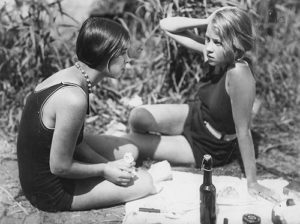You have no items in your cart. Want to get some nice things?
Go shopping Many Berliners follow a similar routine over the summer weekends—they’ll jump on their bikes or the S-Bahn train, leave the heat of the city behind them, and head to one of the many surrounding lakes. Crowds often descend upon the sandy shores of the Wannsee or scramble for a shaded spot on the banks of the Nikolassee. A picnic and beers are a necessity, usually as hair of the dog to combat the hangover from the previous night.
Many Berliners follow a similar routine over the summer weekends—they’ll jump on their bikes or the S-Bahn train, leave the heat of the city behind them, and head to one of the many surrounding lakes. Crowds often descend upon the sandy shores of the Wannsee or scramble for a shaded spot on the banks of the Nikolassee. A picnic and beers are a necessity, usually as hair of the dog to combat the hangover from the previous night.
From watching the silent Weimar film Menschen am Sonntag (People on Sunday), it’s affirming to know that this was also the case in 1929. As the title suggests, the film follows Berliners over the course of a weekend, the bulk of which takes place on the titular Sunday. The plot is a timeless one – after a night of cards and beer, two sets of friends join up for a day at the Nikolassee – and all the flirtations throughout the day, followed by the growing dread of the return of the work week could easily be applied to any contemporary weekend in Berlin.
Menschen am Sonntag is one of the original neo-realist films and is often considered to have had a huge influence on post-World War Two Italian cinema and 1960’s French New Wave. The film’s everyday plot is one major factor in the film’s realism, but the leading attribute that firmly pigeon-holes the film into this genre is the film’s choice of actors—or lack thereof.
Known as a ‘film without actors,’ the low-budget production cast amateurs, who were largely allowed to improvise their ‘lines.’ In the first few scenes the audience is introduced to the five characters and their jobs – wine dealer, film extra, model, taxi driver and sales assistant – which are in fact their real life bread-and-butter jobs. The opening scenes also inform us that the ‘actors’ went back to these same modest jobs straight after shooting wrapped.
Those behind the camera were also fairly green when it came to the film industry, though they were able to use Menschen am Sonntag as a springboard to Hollywood careers—writer Billy Wilder went on to direct the film noir classic Double Indemnity, while directors Robert and Curt Siodmak went on to have Hollywood success with noir and science fiction films.
Shortly after the premiere, most involved in making the film fled Germany to escape Hitler’s increasing power, and the film negatives were lost. There’s no surviving copy of the original 2.014 metre reel, however a shorter version (1.615 metres) found in the Netherlands Film Museum was restored and missing scenes were added using prints found in the Cinémathèque Suisse, Cinémathèque Royale de Belgique and the Fondazione Cineteca Italiana. New intertitles were then created using information from censor’s records, and the Soviet Union-born Australian composer Elena Kats-Chernin took care of a new score.
There’s barely a bum note throughout the film’s seventy-three minutes. The only slight weakness is the odd moment of overacting – in the way children go over the top in school plays – but this can easily be forgiven considering the roll call of amateurs. The use of non-professional actors could make the film feel like a pseudo-documentary, something that, if it were filmed in this day and age, would be cruelly compared to reality TV. Though viewing the film now, around 85 years after it was made, serves as a time machine—its sumptuous shots of children splashing on the banks of the Spree and original ornate facades along Pappelallee’s Mietskaserne (rental barracks) are just some of the unique glances at a Berlin that has now been lost to war. While the overall premise of the film is easy to relate to, it’s the quirks of everyday life in the 1930s, so different from modern Berlin, that are compelling: Berliners back then seem happy to jaywalk in front of horse and carts; suitcases and record players are taken to the lake; everyone has their ticket checked as soon as they alight from the S Bahn.
All these historical oddities, alongside the charm of a non-professional cast, couple perfectly with the light-hearted plot and a gorgeous cinematography that allows you to glide around the city. Ultimately though, it is the film’s time and setting, right at the end of the Weimar republic, that sets it apart from other realism cinema. The shot of the army practising their military steps through the Tiergarten is an ominous reminder of what we are watching—the final moments of a society before it was toppled by the Nazi regime.

About Laura Harker
Laura is based in North Yorkshire and writes about travel and culture.




